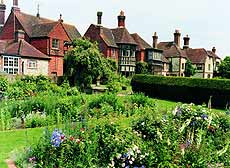|
The attractive village of Selborne and its beautiful countryside is famous for its association with the 18th century naturalist Gilbert White. In his book The Natural History of Selborne he meticulously records his observations on the plants, birds and animals of this lovely part of Hampshire. The Reverend Gilbert White (1720-1793) is regarded as England's first ecologist. He lived at "The Wakes" most of his life. The rooms have been furnished in the 18th century style and include items of his furniture, beautifully embroidered bed hangings and portraits of his family. The original manuscript is also on display. association with the 18th century naturalist Gilbert White. In his book The Natural History of Selborne he meticulously records his observations on the plants, birds and animals of this lovely part of Hampshire. The Reverend Gilbert White (1720-1793) is regarded as England's first ecologist. He lived at "The Wakes" most of his life. The rooms have been furnished in the 18th century style and include items of his furniture, beautifully embroidered bed hangings and portraits of his family. The original manuscript is also on display.
The Garden
Through Gilbert White's writings, the garden is probably one of the best documented of its type and is gradually being restored. Already established are his 'Quincunx', wooden ha-ha, alcove and 'Six Quarters' - beds to display many of the fascinating plants known to White. His brick path leads to the stone ha-ha, sundial and part of his fruit wall. Later additions include a spectacular laburnam arch, topiary and fragrant herb garden: all set against the backdrop of the magnificent beech-clad Selborne hanger.
The Oates Museum is devoted to the remarkable Oates family and in particular, Frank Oates, a Victorian explorer, and to Captain Lawrence Oates who accompanied Scott to the South Pole. There are illustrations and relics of both these adventures with a charming introduction in a "Gentleman's Study".
Tea parlor
Delicious refreshments are served in the restored dining room. Much of the fare is based upon interesting eighteenth century recipes.With the emphasis on unusual and inexpensive gifts and books, there is an excellent gift shop to browse in to find something a little different.
Field Studies Centre
Courses for children and adults on natural history and the environment - 01420 511303.
St Mary's Church, Selborne
At the top of The Plestor (Selborne's village green) is St Mary's Church, open during daylight hours. It was built about 1180 probably on the site of a Saxon church. It contains two fine stained glass windows commemorating Gilbert White. The first depicts St Francis of Assisi, the parish of Selborne and the birds mentioned in The Natural History of Selborne; the second was dedicated to mark the bicentenary of White's death. In the churchyard can be seen the base of the famous yew tree believed to be 1400 years old but sadly blown down in the storms of 1990, together with the grave of Gilbert White himself.
The Lythes and its Zig Zag Path
The Lythes to the east of the village and The Hanger overlooking the village with its zig zag path cut by Gilbert White and his brother, are part of the 275 acres of National Trust meadow, woodland and common and are open all year. A leaflet describing the walks over the land is on sale at Selborne Post Office at in the shop at "The Wakes". |

